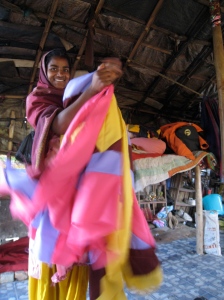
Before leaving Kathmandu, I went to Boudhnath to walk a couple of clockwise koras around the stupa. A Buddhist mecca and all around inspiring place, a visit to Boudha is often the perfect way to begin or end a journey. More than one mountaineer has spun prayer wheels here, believing the gesture is an auspicious start to a Himalayan expedition.
My morning at Boudha was a lovely one. The dome was lit like a half-moon in the early sunlight. Tibetans were already out in force, shuffling around the monument with prayer beads swaying from their fingertips. Some offered marigolds and tika powder to Buddha statues; others crawled on hands and knees, an act of both reverence and self-renunciation. All around the stupa, prayer flags hung illuminated, rows of oil candles switched and burned, travelers composed photographs, and clusters of birds pecked breakfast from walkway cracks. Everyone seemed possessed by a private mission, with a personal prayer, their own reason for being there.
Including me. At noon I had an appointment to meet a new friend at the Boudha entrance. James Hopkins is an American now living in Nepal. He’s carved a full life for himself, undertaking seriously Buddhist studies under a respected Rinpoche. He has other reasons to be there as well, having lately grown attached to a particular community near the stupa: A village of beggars and among the poorest people in already-impoverished Nepal. They live on very little, calling canvass tents “home” and procuring whatever food they can by shining shoes and extending their empty hands on the streets.
Frankly, the place sounded depressing. But James lit up when he talked about the village and was eager to introduce me to the community before I left Nepal.
After leading me down a side street, he took a sharp turn into a cloaked alley. The trash-strewn passage soon opened up to a field. In the field were rows of tents–a whole neighborhood cobbled together with tarps, fraying string, and knobby wood poles. When we entered the “house” of his good friend Bhimla, we were greeted with sparkling eyes and love. It wasn’t long before we were sitting among the family with biscuits and tea.
There is no doubt that James is a friend of the tent-village. Among other things, he’s helped them start a small industry. Using scraps of old saris and salvage fabrics, they hand-stitch quilts of the most spectacular colors. James sells these $140.00 a-piece–the exact amount of money needed to send one of the village children to school for one year. His hope is to leverage them from a life of begging by putting their inherent skills and creativity to use.
What struck me about James’ interaction with the villagers is that he obviously doesn’t feel sorry for them. And he shouldn’t. To my surprise, the village is truly a happy place, full of laughter and fun. And against what would otherwise be a backdrop of bleak brown and army green tarps, the half-made quilts and bolts of fabric offer streaks of jubilant color and hope.
I will post contact info for the project very soon. I encourage everyone to consider buying a quilt as a Christmas gift!

Awesome!
Great blog, Dakini! 😉
I personally know Bhimala she is an enlightened Gypsy Dakini..who empowers many other young Indian and Nepali beggar children to have self-esteem.
James is also wonderful chenrezig heartfelt dude!!